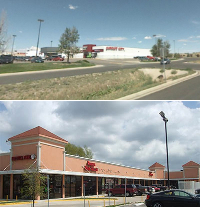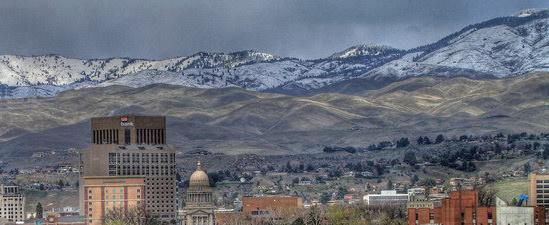Luisa Muradyan Tannahill is originally from the Ukraine and she spent the majority of her childhood in Kansas. She received her MFA from Texas State University and is the editor of Gulf Coast. Her poems have appeared or are forthcoming in Blackbird, West Branch, Ninth Letter, PANK, and Mudlark among others.
"A Small History in a Universal Light": An Exploration of "Brokeback Mountain" as Regional Literature
Luisa Muradyan
Feb 07, 2014
 Can you tell which shopping center is actually in Wyoming? Neither can we. Can you tell which shopping center is actually in Wyoming? Neither can we. |
Back in Cheyenne, Wyoming, another patient at my chiropractor's said he recalled when Dell Range Boulevard, one of Cheyenne's busiest thoroughfares, was barely more than a dirt road. Today Dell Range is paved and painted, lined with the Frontier Mall, box stores, chain restaurants, gas stations, car washes, and the Super Wal-Mart. If I took a picture of Dell Range, anyone who saw it would be hard pressed to place it geographically. It is indistinct, part of the homogenous, seemingly ubiquitous settings we can easily find ourselves in when life calls for a large bag of kitty litter or a chicken Caesar salad. I have wondered with some dismay whether my interest in regionalism isn't increasingly quaint and outdated in this world--a preoccupation akin to my love of fountain pens and manual typewriters. Is there a place (or even a need) for regional literature in a country with increasingly global concerns?
If regionalism started as an "intellectual movement encompassing regional consciousness beginning in the 1930s," then we move farther away from its origins and intentions with each passing day (
Encyclopedia of Southern Culture). The writers behind this movement "sought to treat each of the regions of the country as discrete geographical, cultural, and economic entities," but that kind of compartmentalization would be subject to rabid criticism now, and rightly so (
Encyclopedia of Southern Culture). Who still thinks exclusively in terms of the Mississippi or the Mason Dixon Line? The lines between regions are increasingly in flux; free flowing commerce, culture, and individual lives crest regional borders daily.
When I think about regionalism, I return time and again to those aspects of fiction that arise from, as Flannery O'Connor argues in "The Regional Writer," "the local and the particular and the familiar" (54). Though we haven't become too homogenous to consider the local and particular important, I do find myself replacing "regionalism" with terms like "regional," or "regionalist aesthetic and sensibilities."
Imprecise or clunky as they are, these terms seem more flexible, better-suited to our heterogeneous, contemporary society.
Regardless of my terminology, O'Connor's concerns in "The Regional Writer" still apply some fifty years after its publication. O'Connor laments stories that seem to "have originated in some synthetic place that could have been anywhere or nowhere. These stories hadn't been influenced by the outside world at all," she writes, "only by the television" (56). As a child raised on large daily doses of TV, and as an adult who regularly forgets that the life before me is no less vital than those lived elsewhere, I feel the allure of the synthetic, where secondhand seeing has become firsthand being and feeling. Still, the synthetic isn't what I seek through art. When I read or create, I want an acute experience sharp with new insights.
Searching contemporary American literature for a narrative with a "regional" sensibility--a story cast far from the synthetic--Annie Proulx's "Brokeback Mountain" comes to mind. I don't bring up Proulx just because I'm from Wyoming or because I admire her prose. Or, maybe I do, but "Brokeback Mountain" fashions a world that feels urgent and real. How? To start, Proulx situates her characters Jack and Ennis in a specific and local setting. Proulx weaves place names throughout the story--names specific to Wyoming and (mostly) real within and outside of the fictional world she has created. There are small towns and backwaters like Riverton and Signal, as well as the "high meadows and mountain drainages" Jack and Ennis traverse through the "Big Horns, Medicine Bows, south end of the Gallatins," and the rest of Wyoming's Rocky Mountain Range (271). Were we to put up a map of Wyoming, we could stick pins into the towns, forests, and mountains ranges where the story's human drama unfolds.
Orienting "Brokeback Mountain" in Wyoming doesn't make it regionally "western," however, anymore than a story set in Alabama is somehow "southern." As O'Connor writes, "Southern identity is not really connected with mocking-birds and beaten biscuits and white columns any more than it is with hookworm and bare feet and muddy clay roads" (57). Beyond its setting, what makes "Brokeback Mountain" regional is the sense that its situational subject matter, particular and local as those circumstances are, shapes the drama. Lying in the motel bed together after a four-year separation, Ennis relates the essence of their predicament:
I don't want to be like them guys you see around sometimes. And I don't want a be dead. There was these two old guys ranched together down home, Earl and Rich . . . I was what, nine years old and they found Earl dead in an irrigation ditch . . . Two guys livin together? No. All I can see is we get together once in a while way the hell out in the back a nowhere-- (268)
Here, Ennis's concerns combine elements of the story's situational and psychological subject matter. Two men find themselves passionately in love within one of the most inhospitable settings possible.
"Brokeback Mountain's" timeframe (early 1960s-1980s), rural, small town consciousness, cowboy culture, and homophobia inform Ennis's above statement and the story's circumstances. Proulx never focuses on these regional details as "peculiar quaintness," however (O'Connor 57). Those seeking a romantic vision of cowboys or rural life must look elsewhere. Bull riding tears Jack's body apart; Ennis works two jobs in order to board his horses at a nearby ranch. Jack fantasizes about "a little ranch together, little cow and calf operation," but Ennis sees their lives as fixed. Jack and Ennis's identities are nestled within a particular community in a distinct historical moment that is local, providing Jack and Ennis only a narrow, violent frame of reference for understanding their options. Two Wyoming dropouts with "no prospects, brought up to hard work and privation"--Jack and Ennis share a similar history and they speak the same language (254). Brokeback is part of their language, the most important place on the map of their literal and emotional lives.
Wyoming's land, lifestyle, and culture suffuse Proulx's prose. Even when bleak, these regional sensibilities enliven the text, encouraging us to read Jack and Ennis's "small history in a universal light" (O'Connor 58). For now, that is more than enough reason for me to continue pursuing my private passion for regionalism and my desire to find, for myself and for my writing, the place where my own "peculiar crossroads" of "time and place and eternity [will] somehow meet" (O'Connor 59).
 Works Cited:
Works Cited:
O'Connor, Flannery.
Mystery and Manners: Occasional Prose. Eds. Robert and Sally
Fitzgerald. New York: Farrar, Strauss, and Giroux, 1969. Print.
Proulx, Annie.
Close Range: Wyoming Stories. New York: Scribner, 1999. Print.
"Regionalism."
Encyclopedia of Southern Culture. Chapel Hill: University of North
Carolina Press, 1989.
 Can you tell which shopping center is actually in Wyoming? Neither can we.
Can you tell which shopping center is actually in Wyoming? Neither can we. We think this partially blurred (and clickable) photo from The Poetry Foundation visualizes it quite nicely
We think this partially blurred (and clickable) photo from The Poetry Foundation visualizes it quite nicely Works Cited:
O'Connor, Flannery. Mystery and Manners: Occasional Prose. Eds. Robert and Sally
Fitzgerald. New York: Farrar, Strauss, and Giroux, 1969. Print.
Proulx, Annie. Close Range: Wyoming Stories. New York: Scribner, 1999. Print.
"Regionalism." Encyclopedia of Southern Culture. Chapel Hill: University of North
Carolina Press, 1989.
Works Cited:
O'Connor, Flannery. Mystery and Manners: Occasional Prose. Eds. Robert and Sally
Fitzgerald. New York: Farrar, Strauss, and Giroux, 1969. Print.
Proulx, Annie. Close Range: Wyoming Stories. New York: Scribner, 1999. Print.
"Regionalism." Encyclopedia of Southern Culture. Chapel Hill: University of North
Carolina Press, 1989.

Comments (0)
Add a Comment